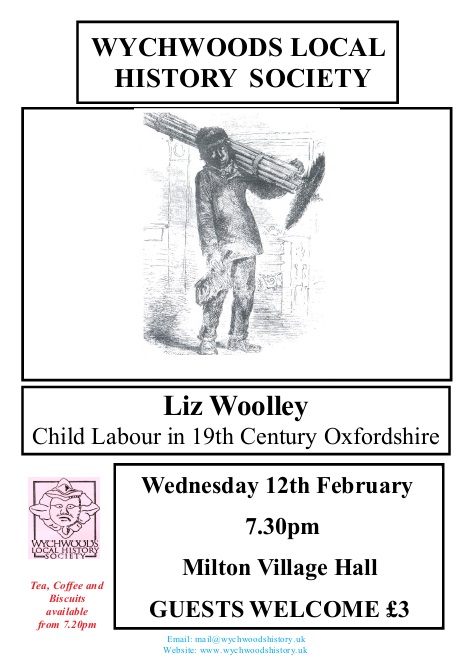
Speaker: Liz Woolley
Subject: Child Labour in 19th Century Oxfordshire
Liz is a freelance local historian. She lives in Oxford and has an MSc in English Local History from the University’s Department for Continuing Education.
Whilst investigating child labour in the Industrial Revolution as part of her MSc she became interested in the experiences of child workers in Oxfordshire: a rural, rather than industrial, county.
A very encouraging group of 60+members and guests came to our latest evening talk and were presented with perhaps some quite counter-intuitive facts about the scale of child labour in the 19th Century England.
The image commonly evoked by the phrase ‘child labour’ is one of young children working in harsh conditions in the grimy factories and mines of the Midlands and the North. Yet in rural counties like Oxfordshire, child labour was as much a feature of everyday life in the nineteenth century as in industrialised areas.
Liz’s hour-long illustrated talk told the story of Oxfordshire’s child workers, many of whom started work part-time at the age of six or seven and, until the compulsory school legislation of the 1870s, left education for good by the age of ten to become permanently employed.
The conflict of attitudes around the need for education for children, especially of the poor, was very much a debate of the times. Many opted for the view that education for the poor was a waste of time. Set against this was, of course, the need for family income, where the alternative of destitution was a very real possibility. Thus, we learn that, even while legislation was being passed, and tightened up, children were still being made to work in a whole range of jobs, with long hours and health-compromising conditions. George Dew, Relieving Officer for the Bicester Poor Law Union reported a child residing at Cottisford working at the age of seven as late as 1873. His report asserted “It will do him more good than going to school”.
Oxfordshire children worked in agriculture. We learned that in 1861 there were 20,000 agricultural labourers in Oxfordshire. 16% of these were under 14 years old, with 300 of them between the ages of 10-14. 300 were actually younger than this.
However, the range of employment was much wider than agriculture. Children were employed in domestic service and in lacemaking, gloving and in a host of other small-scale occupations. Liz’s talk highlighted the differences between girls’ and boys’ experiences of these various occupations, and the particular fates of pauper apprentices.
Liz also highlighted the fact that, contrary to popular belief, cottage industry and agricultural work were by no means the ‘soft option’ in comparison with work in the factories and mines of industrialised areas.
Liz’s talk drew on research from a range of sources, including school logbooks, census returns, newspaper articles, private correspondence and other contemporary accounts, offering us a wealth of detail. We were given much to reflect on in terms of how recently these attitudes to child welfare were the norm and not the exception.
Visit Liz Woolley’s website here >>

